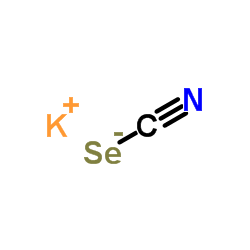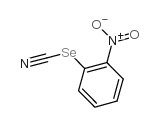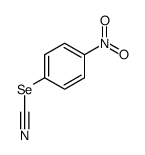3425-46-5
| Name | potassium,selenocyanate |
|---|---|
| Synonyms |
Potassium selenocyanate
Potassium selenoisocyanate K(selenocyanate) Selenocyanic acid, potassium salt (1:1) Selenocyanic acid potassium Selenocyanic acid,potassium salt EINECS 222-320-1 potassium selenocyanide potassium ion selenocyanate MFCD00011366 potassium(II) selenocyanate |
| Density | 2.347 |
|---|---|
| Boiling Point | 134.2ºC at 760 mmHg |
| Melting Point | 147 °C |
| Molecular Formula | CKNSe |
| Molecular Weight | 144.076 |
| Flash Point | 35ºC |
| Exact Mass | 144.883301 |
| PSA | 23.79000 |
| Storage condition | Poison room |
Synonym: Section 2 - COMPOSITION, INFORMATION ON INGREDIENTS
Risk Phrases: 23/25 33 Section 3 - HAZARDS IDENTIFICATION EMERGENCY OVERVIEW
Toxic by inhalation and if swallowed. Danger of cumulative effects.The toxicological properties of this material have not been fully investigated.Hygroscopic (absorbs moisture from the air). Potential Health Effects Eye: May cause eye irritation. Skin: May cause skin irritation. Ingestion: Poison by ingestion. The toxicological properties of this substance have not been fully investigated. Inhalation: The toxicological properties of this substance have not been fully investigated. Toxic if inhaled. Chronic: Not available. Section 4 - FIRST AID MEASURES Eyes: Immediately flush eyes with plenty of water for at least 15 minutes, occasionally lifting the upper and lower eyelids. Get medical aid immediately. Skin: Get medical aid immediately. Immediately flush skin with plenty of water for at least 15 minutes while removing contaminated clothing and shoes. Ingestion: Get medical aid immediately. Wash mouth out with water. Inhalation: Get medical aid immediately. Remove from exposure and move to fresh air immediately. If not breathing, give artificial respiration. If breathing is difficult, give oxygen. Notes to Physician: Section 5 - FIRE FIGHTING MEASURES General Information: As in any fire, wear a self-contained breathing apparatus in pressure-demand, MSHA/NIOSH (approved or equivalent), and full protective gear. Substance is noncombustible. Extinguishing Media: Use extinguishing media most appropriate for the surrounding fire. Section 6 - ACCIDENTAL RELEASE MEASURES General Information: Use proper personal protective equipment as indicated in Section 8. Spills/Leaks: Vacuum or sweep up material and place into a suitable disposal container. Avoid generating dusty conditions. Section 7 - HANDLING and STORAGE Handling: Do not breathe dust, vapor, mist, or gas. Do not get in eyes, on skin, or on clothing. Use only in a chemical fume hood. Storage: Store in a cool, dry place. Store in a tightly closed container. Keep under a nitrogen blanket. Section 8 - EXPOSURE CONTROLS, PERSONAL PROTECTION Engineering Controls: Use adequate ventilation to keep airborne concentrations low. Exposure Limits CAS# 3425-46-5: United Kingdom, WEL - TWA: (listed as selenium compounds): 0.1 mg TWA (except hydrogen selenide, as Se) United Kingdom, WEL - STEL: (listed as selenium compounds): 0.3 m STEL (except hydrogen selenide, as Se) United States OSHA: 0.2 mg/m3 TWA (as Se) (listed under Selenium compounds). Belgium - TWA: (listed as selenium compounds): 0.2 mg/m3 VLE (as Japan: (listed as selenium compounds): 0.1 mg/m3 OEL (except SeH2 SeF6, as Se) Malaysia: (listed as selenium compounds): 0.2 mg/m3 TWA (as Se) Netherlands: (listed as selenium compounds): 0.1 mg/m3 MAC (as Se Spain: (listed as selenium compounds): 0.1 mg/m3 VLA-ED (except hydrogen selenide, as Se) Personal Protective Equipment Eyes: Wear appropriate protective eyeglasses or chemical safety goggles as described by OSHA's eye and face protection regulations in 29 CFR 1910.133 or European Standard EN166. Skin: Wear appropriate protective gloves to prevent skin exposure. Clothing: Wear appropriate protective clothing to prevent skin exposure. Respirators: Follow the OSHA respirator regulations found in 29 CFR 1910.134 or European Standard EN 149. Use a NIOSH/MSHA or European Standard EN 149 approved respirator if exposure limits are exceeded or if irritation or other symptoms are experienced. Section 9 - PHYSICAL AND CHEMICAL PROPERTIES Physical State: Solid Color: white Odor: Stench pH: Not available. Vapor Pressure: Not available. Viscosity: Not available. Boiling Point: Not available. Freezing/Melting Point: 157 - 160 deg C Autoignition Temperature: Not available. Flash Point: Not available. Explosion Limits, lower: Not available. Explosion Limits, upper: Not available. Decomposition Temperature: Solubility in water: Specific Gravity/Density: Molecular Formula: CKNSe Molecular Weight: 144.08 Section 10 - STABILITY AND REACTIVITY Chemical Stability: Not available. Conditions to Avoid: Incompatible materials, exposure to moist air or water. Incompatibilities with Other Materials: Strong oxidizing agents - strong acids. Hazardous Decomposition Products: Nitrogen oxides, carbon monoxide, carbon dioxide, selenium/selenium oxides. Hazardous Polymerization: Has not been reported. Section 11 - TOXICOLOGICAL INFORMATION RTECS#: CAS# 3425-46-5: VT1400000 LD50/LC50: CAS# 3425-46-5: Dermal, guinea pig: LD50 = 50 mg/kg; Oral, mouse: LD50 = 25 mg/kg; Oral, rat: LD50 = 10 mg/kg. Carcinogenicity: POTASSIUM SELENOCYANATE - Not listed by ACGIH, IARC, or NTP. Other: See actual entry in RTECS for complete information. Section 12 - ECOLOGICAL INFORMATION Section 13 - DISPOSAL CONSIDERATIONS Dispose of in a manner consistent with federal, state, and local regulations. Section 14 - TRANSPORT INFORMATION IATA Shipping Name: SELENIUM COMPOUND, N.O.S. Hazard Class: 6.1 UN Number: 3283 Packing Group: II IMO Shipping Name: SELENIUM COMPOUND, N.O.S. Hazard Class: 6.1 UN Number: 3283 Packing Group: II RID/ADR Shipping Name: SELENIUM COMPOUND, N.O.S. Hazard Class: 6.1 UN Number: 3283 Packing group: II Section 15 - REGULATORY INFORMATION European/International Regulations European Labeling in Accordance with EC Directives Hazard Symbols: T Risk Phrases: R 23/25 Toxic by inhalation and if swallowed. R 33 Danger of cumulative effects. Safety Phrases: S 20/21 When using do not eat, drink or smoke. S 28A After contact with skin, wash immediately with plenty of water. S 45 In case of accident or if you feel unwell, seek medical advice immediately (show the label where possible). WGK (Water Danger/Protection) CAS# 3425-46-5: No information available. Canada CAS# 3425-46-5 is listed on Canada's DSL List. CAS# 3425-46-5 is not listed on Canada's Ingredient Disclosure List. US FEDERAL TSCA CAS# 3425-46-5 is listed on the TSCA inventory. SECTION 16 - ADDITIONAL INFORMATION N/A |
CHEMICAL IDENTIFICATION
HEALTH HAZARD DATAACUTE TOXICITY DATA
|
| Symbol |



GHS06, GHS08, GHS09 |
|---|---|
| Signal Word | Danger |
| Hazard Statements | H300-H331-H373-H410 |
| Precautionary Statements | P261-P264-P273-P301 + P310-P311-P501 |
| Personal Protective Equipment | Eyeshields;Faceshields;Gloves;type P2 (EN 143) respirator cartridges |
| Hazard Codes | T:Toxic;N:Dangerousfortheenvironment; |
| Risk Phrases | R23/25;R33;R50/53 |
| Safety Phrases | S20/21-S28-S45-S60-S61 |
| RIDADR | UN 3283 6.1/PG 2 |
| WGK Germany | 3 |
| RTECS | VT1400000 |
| Packaging Group | II |
| Hazard Class | 6.1 |
| HS Code | 2929909090 |
| Precursor 1 | |
|---|---|
| DownStream 9 | |
| HS Code | 2929909090 |
|---|---|
| Summary | 2929909090 other compounds with other nitrogen function VAT:17.0% Tax rebate rate:9.0% Supervision conditions:none MFN tariff:6.5% General tariff:30.0% |











![chloro-[[chloro(difluoro)methyl]disulfanyl]-difluoromethane structure](https://image.chemsrc.com/caspic/020/692-58-0.png)